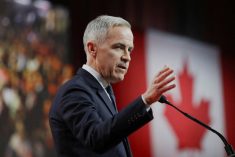Farm safety. The carbon tax. Research funding.
These are the issues that are top of mind for Alberta’s farm leaders heading into the April 16 provincial election.
And no matter which party Albertans elect, provincial farm leaders hope to see some movement on some critical policy decisions.
“Oftentimes, agriculture gets overlooked among other sectors in the economy, but the importance of agriculture is significant,” said Jason Born, chair of Alberta Chicken Producers. “Regardless of which party forms the government, we’re looking to see investments in our key priorities.”
Read Also

Farming Smarter receives financial boost from Alberta government for potato research
Farming Smarter near Lethbridge got a boost to its research equipment, thanks to the Alberta government’s increase in funding for research associations.
And in order for that to happen, the next provincial government will need to work with Alberta’s agriculture industry and regain its trust.
“There has been some erosion of communication between agriculture and the government, and whenever there’s a lack of communication between two groups, there’s always erosion in trust,” said Alberta Canola chair John Guelly.
- Read more: More ag issues for Alberta’s next government
“A continued lack of communication will certainly hurt the industry, so we’d like to see that improved.”
Farmers were already apprehensive of the NDP government after 44 years of Conservative rule in the province, but early missteps on farm safety legislation — particularly a lack of consultation beforehand — heightened tensions and mistrust.
“Our current government had some initiatives that indicated that it had the solution and it introduced the solution prior to comprehensive consultation with the industry,” said Tom Kootstra, chair of Alberta Milk.
“That didn’t work so well for the industry or the government. So we in the agricultural community will be looking for candidates who have a grasp of our issues and are interested in consulting with us in addressing them.”
Born agrees.
“It’s important for the government to meaningfully engage with agriculture when developing regulations and policy, regardless of which party forms the government.”
Farm safety
That didn’t happen when farm safety legislation was introduced in 2015, said Alberta Barley chair Dave Bishop.
“The problem with Bill 6 was they didn’t consult with agriculture well enough to make a really informed decision on how to address safety,” he said.
There are still “a lot of hard feelings over that” among farmers, said Gary Stanford, chair of Alberta Wheat.
“I don’t know if we need to start totally from scratch, but we can always work to make safety concerns better,” he said.
And while the eventual consultation for Bill 6 resulted in some “good things” for Alberta’s agriculture industry, some of the regulations introduced aren’t practical for farming operations, Guelly added.
“They aren’t necessarily adding more safety to the farm — just more bureaucracy,” he said. “We certainly want to keep our families and everyone who works on our farm safe, but I think there’s some things within that legislation that could certainly be looked at.”
One positive was the creation of AgSafe Alberta, which now provides safety training and resources for farmers, said Don Shepert, chair of Alberta Pulse Growers.
“AgSafe Alberta is a really good example of how farmers have worked together and put together a good program for farm safety,” he said. “Bill 6 didn’t start out very well, but we’ve come a long ways in accepting and building these things. So to scrap Bill 6 right now might not be the best.”
But Charlie Christie, chair of Alberta Beef Producers, would like to see the legislation repealed and replaced with farmer-led legislation.
“Our feeling (at Alberta Beef Producers) all along was that Bill 6 was flawed,” said Christie. “It doesn’t matter who’s in government — we’ll be lobbying to start over on that file. The farther down the road we get with this legislation, it just doesn’t fit.”
Carbon tax
Not surprisingly, the tax on carbon dioxide emissions ($20 per tonne when introduced in 2017 and raised to $30 last year) is not popular with farm leaders.
“It keeps chewing away at our bottom line,” said Guelly, who farms near Westlock. “It seems like you can’t do anything on the farm or put anything in the ground without facing the carbon tax. All of the little bits certainly add up to a lot.”
While farm fuel is exempt, it affects other energy costs, such as propane for grain drying.
“If it’s gone tomorrow, I would be happy,” said Barons-area producer Bishop. “But if it isn’t gone tomorrow, we need to work with the government to mitigate those impacts on farms.”
Stanford said his energy bills have gone up sharply since the carbon tax was introduced. His electrical bill jumped from $2,200 in 2016 to $6,000 in 2018, he said, although it’s not clear how much is from carbon taxes that his energy company has passed along and how much from transmission fees (which jumped in 2018 for a variety of reasons).
Still, it’s money out of his pocket, he said.
“We can’t pass on the costs with our grain. We’re price-takers, not price-givers. It makes us quite uncompetitive.”
And that’s even more pronounced after a wet fall like in 2018.
“The big farmers up here are set up to dry their grain, and the carbon tax has added so much expense to the cost of drying grain,” said Shepert, who farms near St. Paul. “You just can’t get back that extra cost.”
Livestock producers are also affected.
“The chicken sector has a fairly significant stake in the carbon tax, particularly because we use a significant amount of natural gas to maintain optimal barn conditions for the livestock under our care,” said Born, who farms near Legal. “We’ve been asking the government for an exemption, as this is something that’s been a problem for a number of years.”
Kootstra isn’t convinced the tax is actually changing behaviours at the farm level.
“I still need to heat my barns. I still need to cool my milk. Our commodities come in by truck and leave by truck,” said the Ponoka-area farmer.
“It’s not that the carbon levy is going to change our practices.”
Christie would also welcome a repeal of the tax.
“I don’t think they realized how uncompetitive the carbon tax makes our province, whether federally or provincially,” said the Trochu-area rancher. “It puts us on a different playing field than a lot of our competitors. We need a strong industry to make a difference, and these types of initiatives just kill our industry.”
Research funding
Additional ag research could help level that playing field — but provincial funding has been whittled away over the past four years.
Before the Alberta Livestock and Meat Agency (ALMA) was dismantled in 2016, the province was investing $12.9 million in the livestock industry. That dropped to $7.2 million in 2016-17 as ALMA was folded into Alberta Agriculture and Forestry. In 2017-18, funding dropped further, to $12.3 million — split between the livestock and cropping sectors (including investment in Genome Alberta).
“There was a lot of good work done through ALMA, and we believe it pushed Alberta’s livestock industry forward substantially,” said Born. “Now the crop sector and the livestock sector are essentially accessing the same pool of funds, and the funding has not kept up with the increased number of applicants.”
It’s a similar story with crop research funding. In 2018, the Alberta Crop Industry Development Fund (ACIDF) was dismantled after 17 years of operation. Five years ago, it was investing between $5 million and $7 million into crop research, with an additional $4 million to $5 million invested by Alberta Innovates Bio Solutions. But that changed in recent years, prompting the ACIDF board to close down shop last April as its provincial funding reached an end.
Alberta’s farmers are already feeling the effects of this reduced funding, the farm leaders say.
“When you take away one funding model with no plan in place, it’s been very difficult for us to figure out the funding for the future,” said Stanford. “We need innovation and research for the livestock sector and the crop sector, so we need some kind of new program for the future.”
The province risks losing its research capacity if this funding gap isn’t dealt with soon, Christie added.
“We have some state-of-the-art facilities and world-class researchers that we’re at risk of losing if we don’t adopt a decent framework and get things rolling,” he said.
“If you’re not getting better, you’re falling behind,” added Guelly. “We need to keep research moving so that we can become more efficient and overcome more obstacles while producing our crops at a lower cost and providing a better product to our customers.”
All three issues affect the competitiveness of Alberta’s ag sector, the farm leaders say.
“Our margins in agriculture are generally pretty low at the farm gate,” said Bishop. “If they want to keep us competitive, they need to have these issues addressed.”















